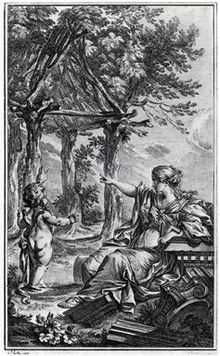Primitive hut

The primitive hut had been standard in architectural theory since Vitruvius. Marc-Antoine (Abbe) Laugier brought the idea to life with an image of the hut as the frontispiece for the second edition of Laugier's Essay on Architecture (1755).
The theory states that Ancient Greek temples owed their form to the earliest habitations erected by man. In the primitive hut, the horizontal beam was supported by tree trunks planted upright in the ground and the roof was sloped to shed rainwater. This was the inspiration behind the basic Doric order.[1]
It was sought to be the ideal principle for architecture or any structure at the time. Laugier believed it was the standard form which all architecture embodied.
Frank Lloyd Wright is believed to have used the idea of the primitive hut heavily in many of his designs. A design with this in mind is characterized with an emphasized hearth, roof, and foundation.
References
- ↑ John Soane: Master of Space & Light, Royal Academy p.119